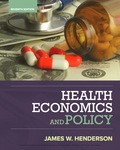Economics of Education Problem Set 1 1. When economists discuss education markets, what do they mean? How do education markets differ from other types of markets like the market for cars or shoes?
Economics of Education Problem Set 1 1. When economists discuss education markets, what do they mean? How do education markets differ from other types of markets like the market for cars or shoes?
Principles of Economics 2e
2nd Edition
ISBN:9781947172364
Author:Steven A. Greenlaw; David Shapiro
Publisher:Steven A. Greenlaw; David Shapiro
Chapter2: Choice In A World Of Scarcity
Section: Chapter Questions
Problem 7SCQ: Would a research study on the effects of soft drink consumption on childrens cognitive development...
Related questions
Question

Transcribed Image Text:Economics of Education Problem Set 1
1. When economists discuss education markets, what do they mean? How do education markets
differ from other types of markets like the market for cars or shoes?
2. Question #2 is an analysis of consumer behavior with respect to education using budget
constraints and indifference curves.
a. Draw the budget line between education and all other goods facing a consumer.
Assume that public education is some standardized amount and that the alternative,
private education, can be purchased in varying amounts. (Hint: The budget constraint
here is not only a line but also a point outside the line.)
b. Draw an indifference curve that would imply the consumer would not accept the offer
of free public education. In other words, draw an indifference curve such that a point on
the ordinary, market budget line is on a higher indifference curve than is the point for
the standardized amount of public education.
c. Draw an indifference curve implying the consumer would accept the free public
education and would consume more education than he would without the offer.
d.
Draw an indifference curve implying the consumer would accept free public education
but would consume less education than he would without the offer.
e.
When would you expect an offer of free public education to reduce rather than raise the
educational attainment of the population?
3. What is selection? Why does selection make it difficult to estimate the causal effect of
education policies? Discuss how randomized controlled trials overcome issues related to
selection.
4. Use human capital theory to explain why investments in education tend to occur at younger
ages.
5. Bill is a history teacher who earns $50,000 each year, Kevin is unemployed. Bill and Kevin want
to go earn an MBA degree and later open their own business. Each would pay the same tuition
for their MBA. Do they both face the same cost of enrolling in the program? Explain.
6. A study shows that for American high school dropouts, obtaining a General Equivalency Degree
(GED) by part-time study after high school has very little pay-off. It also shows, however, that for
immigrants who did not complete high school in their native countries, obtaining a GED has a
relatively large payoff. Can signaling theory be used to explain these results?
7. Suppose there are two types of employees: high productivity (H) and low productivity (L).
Employers cannot distinguish between the two types during the job interview (i.e. it's difficult to
tell who is actually productive or not by just talking with them). Assume that:
a. The employer values getting a high productivity worker at $20; they value a low
productivity worker at $10.
b. That education costs 2y for a high productivity worker and 2.5y for a low productivity
worker, where y represents years of schooling.
c. That high-productivity workers make up 25% of the population
What is the pooling equilibrium wage?
What values of y will lead to a separating equilibrium?
Show Transcribed Text
please help for questions 1-7
Expert Solution
This question has been solved!
Explore an expertly crafted, step-by-step solution for a thorough understanding of key concepts.
Step by step
Solved in 3 steps

Knowledge Booster
Learn more about
Need a deep-dive on the concept behind this application? Look no further. Learn more about this topic, economics and related others by exploring similar questions and additional content below.Recommended textbooks for you

Principles of Economics 2e
Economics
ISBN:
9781947172364
Author:
Steven A. Greenlaw; David Shapiro
Publisher:
OpenStax



Principles of Economics 2e
Economics
ISBN:
9781947172364
Author:
Steven A. Greenlaw; David Shapiro
Publisher:
OpenStax



Essentials of Economics (MindTap Course List)
Economics
ISBN:
9781337091992
Author:
N. Gregory Mankiw
Publisher:
Cengage Learning

Brief Principles of Macroeconomics (MindTap Cours…
Economics
ISBN:
9781337091985
Author:
N. Gregory Mankiw
Publisher:
Cengage Learning
